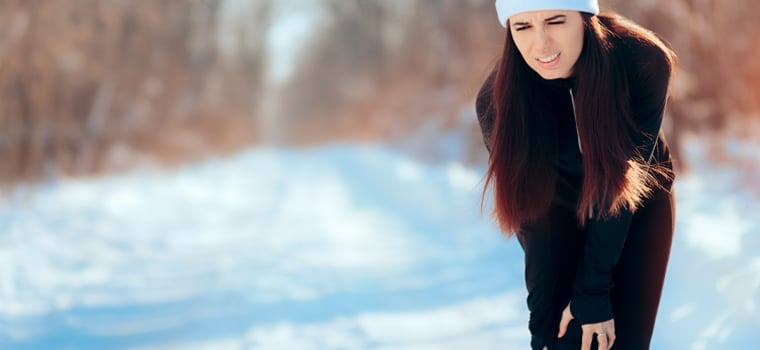Joint pain is oftentimes a sign of injury or an underlying health condition. But cold weather joint pain can be a totally different beast. For some people, cold weather brings on a particular low-level joint pain or achiness.
Maybe you’ve experienced it yourself after a long December run, or heard someone comment that the weather is “making their knees ache.” The idea of cold weather joint pain seems a bit far-fetched, but it’s not just your imagination.
What causes cold weather joint pain?
“Generalized joint pain, more specifically in the knees, is a common complaint that we hear during fall and winter seasons,” Lauren Farrell, M.S.P.T., a physical therapist and clinic director of Professional Physical Therapy in Hoboken, N.J., tells SELF.
There’s a lack of research to prove why this happens, Farrell says, but experts have a few theories. “The research suggests that in colder weather, the body will conserve heat, and it will send more of the blood to the organs in the center of the body, like the heart or the lungs,” Armin Tehrany, M.D., orthopedic surgeon and founder of Manhattan Orthopedic Care, tells SELF. “So when that happens, the arms, legs, shoulders, knee joints, those blood vessels will constrict,” he says. Less blood flow makes those areas colder and stiffer, which can cause discomfort and pain.
The other common theory is that “when it is cold and/or damp out, changes in barometric pressure can cause an inflammatory response in the joints,” Farrell says. “This response could lead to increased joint pain, due to changes in circulation and possible nerve fiber sensitivity.” However, there’s a lack of evidence to confirm or deny whether these responses are actually occurring in the body, she says.
Cold weather joint pain tends to be most common in the knees, hips, and ankles.
While it can happen in any part of the body, this cold weather achiness is most common in weight-bearing joints—and the major joints that fall into this category are the knees, hips, and ankles. “This is especially true for the running population, where they tend to be spending longer periods of time exercising outside in the cold,” Farrell says.
How can you relieve cold weather joint pain?
No matter the cause, winter stiffness and achiness is something many people experience. Luckily, avoiding it is as easy as keeping yourself warm. That means warming up properly before working out and wearing appropriate clothing if you’re going to be outside. (Here, you can find a few cold weather running gear recommendations from an experienced winter runner.)
A proper warm-up and stretching will also help keep everything more limber—which is important to prevent stiffness from turning into an injury. “Joint pain alone doesn’t necessarily lead to injuries, but if the pain is caused by stiffness and you don’t address it and it gets worse, that can cause injury,” says Tehrany. In general, for an activity like steady-state running, you want to at least warm up for 5 minutes (and possibly longer if you’re running outdoors) inside or outside, SELF reported previously.
And during your run, if you stop and take breaks, keep in mind that your joints and muscles may start to feel stiff as your body temperature lowers, so implement dynamic movement even during pauses in your run to keep yourself warm and limber.
“After running, it is also important to make sure you incorporate a proper cool-down, followed up by stretching/foam rolling to decrease tightening in the muscles after exercising,” Farrell says. And on rest days? Tehrany suggests daily stretching and dressing in warm-enough clothes to avoid stiffness.
And on extremely chilly days, consider taking your workout indoors if cold weather joint pain is a big issue for you. Instead of hitting the snow-covered pavement, hop on the treadmill or another cardio machine of choice, or try this 20-minute indoor cardio circuit that’s a perfect alternative when the weather isn’t working in your favor. If your body is signaling to you that certain running conditions are uncomfortable or even painful, listen to it.
This also goes for people with certain underlying health conditions that might make them especially vulnerable to body and/or joint pain in colder weather, such as people who have rheumatoid arthritis or Raynaud’s disease, which is a disorder involving the blood vessels that is often triggered by cold temperatures.
If these strategies don’t alleviate your joint pain, see your doctor.
If you get into a good stretching and warm-up routine and still notice pain in your joints, talk to an orthopedist or physical therapist to make sure you’re not injured. “It is important to remember that pain is your body’s warning system, and you need to listen to it,” says Farrell. “Consistent joint pain could be the beginning signs of arthritis, and it is best to address it earlier on.”
And of course, having joint pain or stiffness year-round—not just when the temps are low—is also a warning sign. “This could mean a structural problem in the knee cap or joint,” says Tehrany, and should be addressed by an expert.
Article Courtesy of: https://www.self.com/story/why-joints-hurt-more-cold-winter-weather









